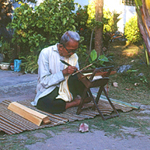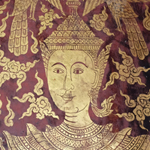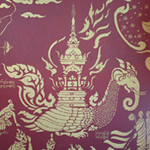Northern Thai Literary Tradition
Background
Northern Thailand possesses distinct cultural and literary traditions, which have made an essential contribution to the development of related cultures throughout the region, but its rich manuscript collections have remained severely under-researched due to a lack of accessibility, despite an abundance of primary sources. In addition to local texts from the Theravada Buddhist tradition, there is a wealth of indigenous literature and historical writings, as well as works pertaining to social relations, customary law, astrology, magic, mythology and rituals, grammar and lexicography, as well as poetry and epic stories, folk tales and romances. A large number are extra-canonical works consisting of narrative literature, especially Jataka stories, many of which are thought to originate from local Southeast Asian traditions. Texts are found in the Northern Thai (Lan Na), Tai Khuen, Tai Lue, Lao, Shan, Burmese, and Pali languages, and are written in a variety of scripts.
The oldest extant manuscripts are monolingual Pali texts dating from the late 15th century CE when Chiang Mai was a regional centre for the study and dissemination of Buddhist literature, and the earliest dated manuscript, of the Tiṁsati nipāta section of the Jātaka aṭṭhakathā vaṇṇanā, was copied in 1471 CE (CS 833). There are relatively few manuscripts from the 17th and early 18th centuries, during the period of Burmese suzerainty over the region, but the following decades saw a resurgence in manuscript production. Many date from the early 19th century, when Khruba Kancana, a charismatic scholar monk, developed Wat Sung Men, Phrae, as a centre of Pali and Buddhist studies, and initiated and mobilised support for the collection and copying of manuscripts in many parts of what is now Northern Thailand and in Luang Prabang, Laos. The entire library collection at Wat Sung Men, which contains over 1,700 manuscripts and is the largest in Northern Thailand, was microfilmed as part of the Preservation of Northern Thai Manuscripts Project (PNTMP), and is now available in the digital library.
Preservation
In the early 20th century, centralised administrative and monastic reforms from Bangkok effectively supressed the use of the local Lan Na script and its related manuscript culture, and since the early 1960s, there have been ongoing efforts to preserve the regional literary tradition. The Siam Society supported a survey of manuscripts at Wat Lai Hin in Lampang Province, undertaken by Ajarn Singkha Wannasai, a leading local scholar, which was completed in 1966, and Ajarn Singkha was also instrumental in the Dokumentarische Erfassung literarischer Materialien in den Nordprovinzen Thailands (DELMN) project, conducted by Harald Hundius in the early 1970s. Images from microfilms produced during the DELMN project, together with those of a large number of handwritten notebook copies of manuscripts (HHHWC), are included in the present digital library.
A separate project, taken over in 1981 by the newly established Social Research Institute (SRI) of Chiang Mai University, catalogued and microfilmed over 4,000 manuscripts, the majority of which cover secular fields of knowledge such as traditional law, customs, astrology, history and medicine, etc. Chiang Mai University’s Center for the Promotion of Arts and Culture then implemented the Preservation of Northern Thai Manuscripts Project (PNTMP) from 1987 to 1991, which included the largest survey of manuscripts to date in Northern Thailand. PDF copies of the survey data sheets are available in the Resources section of this website. This project also produced over 400 rolls of microfilmed manuscripts (now held by Chiang Mai University Library (CMUL)), which form the bulk of the present digital library. CMUL has also directly digitised a number of manuscripts, and has an online catalogue, the CMUL Digital Heritage Collection.
Since 2005, the École française d’Extrême-Orient (EFEO) has worked on the cataloguing and digitisation of Northern Thai chronicles and other texts, which are available online on its Lanna Manuscripts website. The Palm Leaf Studies Centre and Institute of Lanna Studies at Chiang Mai Rajabhat University has also done extensive work on the cataloguing and digitisation of manuscripts in Northern Thailand and especially of the closely-related Tai Khuen (in Shan State, Myanmar) and Tai Lue (in Sipsongpanna, Yunnan Province, China).
The Digital Library of Northern Thai Manuscripts project, which began in 2013, makes several of the above collections available online, together with a number of texts directly digitised during the project.
Details of further reading materials and links are available in the Resources section of this website.
DLNTM Collections
The DLNTM digital library contains images of manuscripts from four collections:
Preservation of Northern Thai Manuscripts Project (PNTMP): 3,914 manuscripts 159,564 images
The PNTMP collection, which forms the bulk of the digital library, contains greytone images digitised from microfilm. The PNTMP project was initiated by Harald Hundius while he was a guest lecturer and research adviser to help establish a Master’s Degree programme in Lan Na Language and Literature in the Thai Department of Chiang Mai University from 1983 to 1992. The project was implemented by Chiang Mai University’s Center for the Promotion of Arts and Culture and was funded by the German Federal Foreign Office through its Cultural Assistance Programme from 1987 to 1991, with M.R. Rujaya Abhakorn as Project Leader.
In addition to survey and preservation work throughout Northern Thailand, over 400 rolls of microfilms containing selected primary sources of the Lan Na tradition were produced at the suggestion of the German Federal Foreign Office, including the entire manuscript collection of Wat Sung Men in Phrae Province (over 150 rolls of microfilm). Copies of the microfilms are kept at the National Archives of Thailand, Chiang Mai University Library (CMUL), and at the Akademie der Wissenschaften und der Literatur, Mainz, Germany.
With the kind permission of CMUL, the microfilms were digitised in Germany in 2012-2013, and the images have been made available under a Creative Commons Attribution-NonCommercial 4.0 Unported (CC BY-NC 4.0) License (with the exception of medical treatises). The digitisation, which was also funded by the German Federal Foreign Office, was undertaken by Herrmann und Kraemer GmbH, and the images were edited and renamed by the Digital Library of Lao Manuscripts project (DLLM) at the National Library of Laos.
The collection has a strong focus on indigenous (Southeast Asian) and secular traditions, in addition to containing possibly the oldest dated Pali manuscripts in Southeast Asia. The selection of the holographs was done according to historical importance, cultural diversity and regional representation, and the age and quality of the manuscript.
See PDF copies of the PNTMP survey datasheets.
Digital Library of Northern Thai Manuscripts (DLNTM): 1,051 manuscripts 39,547 images
The DLNTM collection contains colour images of manuscripts directly digitised in Northern Thailand. During the PNTMP project survey in the 1980s, over 6,000 important texts were selected for microfilming, but due to time constraints over 2,000 of the selected texts were not microfilmed during the project timeframe. In particular, no microfilming was conducted in Chiang Rai and Lamphun provinces, and was conducted at only one temple in the whole of Chiang Mai Province (90 manuscripts at Wat Chiang Man).
In conjunction with the Digital Library of Northern Thai Manuscripts project, the German Federal Foreign Office funded the direct digitisation of texts in 39 temples. The digitisation was conducted by a local team in Northern Thailand between 2013 and 2017 and the resulting images were edited and renamed by the Digital Library of Lao Manuscripts project at the National Library of Laos.
Dokumentarische Erfassung literarischer Materialien in den Nordprovinzen Thailands (DELMN): 991 manuscripts 13,419 images
The DELMN collection contains greytone images digitised from microfilm. The DELMN project was the first comprehensive survey of Lan Na manuscripts in the eight northernmost provinces of Thailand, conducted by Harald Hundius from 1971 to 1974, and was funded by the German Research Foundation (DFG). Ajarn Singkha Wannasai, a well-known scholar of Lan Na literature and leader of local temple ceremonies, was instrumental in the implementation of the survey. The scope of the research covered not only literary sources of Northern Thai, but also Buddhist and historical texts, law, astrology, medicine, etc.
Microfilming was undertaken in almost 100 locations and about 25 rolls of microfilm were produced (including many fragments of rolls), with the frames in portrait orientation and 12-15 folios in each image. Where the frames include folios from more than one text, the digital images have been duplicated to be included with each separate online text. In several cases where the same texts were later microfilmed in the PNTMP project, both versions are included in the digital library. The digitisation, which was funded by the German Federal Foreign Office, was undertaken by Herrmann und Kraemer GmbH, and the images were edited and renamed by the Digital Library of Lao Manuscripts project at the National Library of Laos.
Harald Hundius Handwritten Collection (HHHWC): 181 manuscripts 21,222 images
The HHHWC collection contains colour images of manuscript texts copied into notebooks by local scribes in the early 1970s, during the course of the DELMN project. Most of the scribes were monks selected from temples in Lamphun Province by Ajarn Singkha Wannasai. The texts, which comprise over 21,000 pages, were largely copied from manuscripts in the temples in which the scribes resided, and provide a testament to the living scribal tradition at that time. The digitisation, which was funded by the German Federal Foreign Office, was undertaken by Herrmann und Kraemer GmbH, and the images were edited and renamed by the Digital Library of Lao Manuscripts project at the National Library of Laos.
DLNTM Project
Funding
The principal funders of the Digital Library of Northern Thai Manuscripts are the Henry Luce Foundation and the German Federal Foreign Office (Auswärtiges Amt), with further significant support from the Andrew W. Mellon Foundation, the University of Pennsylvania Libraries and the School of Arts and Sciences at the University of Pennsylvania.
Collaboration
In addition to the funding sources, the project was made possible through the collaboration of the University of Pennsylvania, Chiang Mai University, the National Library of Laos, and the Berlin State Library, and through the work of Herrmann und Kraemer GmbH (for digitisation), Justin Reese and Justin MacCarthy (for website creation), Ubonphan Wannasai, Santisart Wannasai, and Ven. Jatupol Promnuchanont (for direct digitisation in Northern Thailand), Chaichuen Khamhaengyodtai (for cataloguing Shan manuscripts), and Amaralak Khamhong (for Thai translation). Special thanks also goes to the local temples for their permission and support for the direct digitisation of manuscripts in Northern Thailand.
The University of Pennsylvania, was instrumental in securing and administering US funding for the project, with Justin McDaniel, Professor of Religious Studies, as Project Leader. It also archives a copy of the digital images.
Chiang Mai University Library (CMUL) allowed the Preservation of Northern Thai Manuscripts Project (PNTMP) microfilms to be digitised and for the images to be made freely available in the digital library under a Creative Commons Attribution-NonCommercial 4.0 Unported (CC BY-NC 4.0) License (with the exception of those related to traditional medicine). It also archives a copy of the digital images.
The German Federal Foreign Office (which also funded the PNTMP project in the 1980s), funded digitisation of all images from microfilm and notebooks, and directly digitisation at 8 temples.
The Berlin State Library hosts the server for the Digital Library of Northern Thai Manuscripts (as well as the Digital Library of Lao Manuscripts), and is committed to its long-term maintenance beyond the project timeframe. It also archives a copy of the digital images.
The Digital Library of Northern Thai Manuscripts project was designed by Harald Hundius and David Wharton at the National Library of Laos, based on the Digital Library of Lao Manuscripts. With the exception of direct digitisation in Northern Thailand, the project was implemented by DLLM staff at the National Library of Laos, which also provided an in-country project office, logistical support and communications facilities, and archives a copy of the digital images.
Bounchan Phanthavong, Head of the Manuscripts and Rare Books Section of the National Library of Laos, was the main researcher responsible for the collection of inventory data, which was entered by Bouasy Sypaseuth, who also edited the digital images of manuscripts.
David Wharton, the Technical Director of the project, provided overall project management as well as English and romanised data entry, and collaborated with Justin Reese and Justin MacCarthy on the design of the database and website. He also provided the webpage text and unless otherwise stated took the images which appear on the webpages and in the gallery.
Harald Hundius, Professor Emeritus of Thai and Lao Languages and Literatures at the University of Passau, Germany, was local Project Leader. His central role in the realisation of the project dates back to his initial work on Northern Thai manuscripts in the early 1970s, and his participation in the Preservation of Northern Thai Manuscripts Project (PNTMP). in the 1980s, and the microfilms and handwritten notebooks produced during those projects are now included in the digital library. His long association with Chiang Mai University (which awarded him an honorary doctorate in 2000), with the German Fedral Foreign Office, and with local temples throughout Northern Thailand, was instrumental in securing the necessary agreements and funding for the implementation of the project.
Technical Details
Images
Digitisation conducted in Germany by Herrmann und Kraemer GmbH used a Zeutschel OM 1600 roll film scanner for the PNTMP and DELMN microfilms, and a Zeutschel OS 12000 book scanner for the HHHWC notebooks. All image enhancements took place in Adobe Photoshop CS 6.
After extensive checking against local copies of the microfilms, the approved images were sent to the National Library of Laos in TIFF format, where they were edited and renamed by the Digital Library of Lao Manuscripts project using Adobe Lightroom 5, and 300ppi TIFF archival quality master copies and 72ppi JPEG derivatives for Internet use were produced. As part of the editing process, survey code numbers and copyright information were added to the images, and other details also added to the EXIF metadata for each image.
Direct digitisation in temples in Northern Thailand used a Nikon D610 digital SLR (FX format) camera with an AF-S NIKKOR 50mm f/1.4G lens, mounted on a Gitzo 6X Explorer 4S tripod with two attached Kaiser Starcluster daylight temperature LED lights. The camera was tethered to a MacBook Pro laptop computer and operated using Nikon Camera Control Pro 2 software. This provided an easily portable solution when visiting temples. The resulting RAW images were backed up on an external hard disk at the end of each day and periodically transported to Vientiane for editing at the National Library of Laos. All photographic work took place in the temples, and no manuscripts were removed.
Image editing in Adobe Lightroom 5 included white balance adjustment (the first two master images of each manuscript include X-Rite ColorChecker Passport colour and white balance targets for this purpose), lens distortion correction, adding code numbers and watermarks with copyright statements, and EXIF metadata (with GPS coordinates and details of digitisation, copyright, etc.). Folio numbers were then added in Adobe Photoshop, and 300ppi TIFF archival copies and 72ppi JPEG derivatives (for use on the website) were created.
The edited images are archived at the Berlin State Library (which also hosts the server for the digital library), Chiang Mai University Library, the University of Pennsylvania, and the National Library of Laos, providing best-practice data redundancy. For security, separate copies were kept by the digitisation company for one year, until well after the archival process was completed.
To complement the manuscript images, digital photographs were also taken of temples, manuscript repositories, chests, scribes, and the direct digitisation process, etc., and are included in the Gallery section of the website.
Naming
The name of each digital manuscript image contains information identifying its precise location in each microfilm collection as well as code numbers assigned to each text during survey and preservation work. The code numbers themselves identify the location, category, and manuscript bundle of the original text. For example, images from the Preservation of Northern Thai Manuscripts Project (PNTMP) microfilms are named PNTMPaaa_bbb_ccccccccc_cc_ddd, where aaa is a new running number given to the microfilm rolls in the PNTMP collection, bbb is a running number of the frame within that microfilm roll, ccccccccc_cc is the PNTMP survey code number for the text (with the first 2 digits replacing previous letters), and ddd is the running number for that digital image frame within the text.
A similar system is used to uniquely identify directly digitized texts, again including the PNTMP code numbers, where available. Texts in the DELMN and HHHWC collections have unique 4-digit code numbers in place of ccccccccc_cc above.
A number of frames were re-taken during microfilming, and for simplicity the inferior quality duplicates are archived but not made available via the website, which means that the running number of the microfilm frames (bbb) is not always consecutive.
Where available at the time of digitisation, images of survey data sheets are also included with each text, with DS1 replacing the 3-digit running number for the digital image frame within the text (ddd). PDF copies of all the PNTMP survey data sheets are available in the Resources section of this website.
Terms of Use
The digital images of microfilmed manuscripts (with the exception of those related to traditional medicine in the PNTMP collection) and other images and data are made freely available under a Creative Commons Attribution-NonCommercial 4.0 Unported (CC BY-NC 4.0) License (see the link for the terms of this license). The names of the creators, attribution parties and copyright notices are included in the EXIF data for each image. Please contact us if you have questions about usage under this license, providing appropriate credits, or if you would like to use any of the contents of the website in commercial publications.
Further technical details are available upon request.




